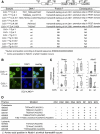Modeling T-cell acute lymphoblastic leukemia induced by the SCL and LMO1 oncogenes
- PMID: 20516195
- PMCID: PMC2878648
- DOI: 10.1101/gad.1897910
Modeling T-cell acute lymphoblastic leukemia induced by the SCL and LMO1 oncogenes
Abstract
Deciphering molecular events required for full transformation of normal cells into cancer cells remains a challenge. In T-cell acute lymphoblastic leukemia (T-ALL), the genes encoding the TAL1/SCL and LMO1/2 transcription factors are recurring targets of chromosomal translocations, whereas NOTCH1 is activated in >50% of samples. Here we show that the SCL and LMO1 oncogenes collaborate to expand primitive thymocyte progenitors and inhibit later stages of differentiation. Together with pre-T-cell antigen receptor (pre-TCR) signaling, these oncogenes provide a favorable context for the acquisition of activating Notch1 mutations and the emergence of self-renewing leukemia-initiating cells in T-ALL. All tumor cells harness identical and specific Notch1 mutations and Tcrbeta clonal signature, indicative of clonal dominance and concurring with the observation that Notch1 gain of function confers a selective advantage to SCL-LMO1 transgenic thymocytes. Accordingly, a hyperactive Notch1 allele accelerates leukemia onset induced by SCL-LMO1 and bypasses the requirement for pre-TCR signaling. Finally, the time to leukemia induced by the three transgenes corresponds to the time required for clonal expansion from a single leukemic stem cell, suggesting that SCL, LMO1, and Notch1 gain of function, together with an active pre-TCR, might represent the minimum set of complementing events for the transformation of susceptible thymocytes.
Figures





References
-
- Aifantis I, Raetz E, Buonamici S 2008. Molecular pathogenesis of T-cell leukaemia and lymphoma. Nat Rev Immunol 8: 380–390 - PubMed
-
- Armstrong SA, Staunton JE, Silverman LB, Pieters R, denBoer ML, Minden MD, Sallan SE, Lander ES, Golub TR, Korsmeyer SJ 2002. MLL translocations specify a distinct gene expression profile that distinguishes a unique leukemia. Nat Genet 30: 41–47 - PubMed
-
- Armstrong F, Brunet de la Grange P, Gerby B, Rouyez MC, Calvo J, Fontenay M, Boissel N, Dombret H, Baruchel A, Landman-Parker J, et al. 2009. NOTCH is a key regulator of human T-cell acute leukemia initiating cell activity. Blood 113: 1730–1740 - PubMed
-
- Begley CG, Aplan PD, Davey MP, Nakahara K, Tchorz K, Kurtzberg J, Hershfield MS, Haynes BF, Cohen DI, Waldmann TA, et al. 1989. Chromosomal translocation in a human leukemic stem-cell line disrupts the T-cell antigen receptor δ-chain diversity region and results in a previously unreported fusion transcript. Proc Natl Acad Sci 86: 2031–2035 - PMC - PubMed
Publication types
MeSH terms
Substances
Grants and funding
LinkOut - more resources
Full Text Sources
Other Literature Sources
Molecular Biology Databases
Research Materials
Miscellaneous
